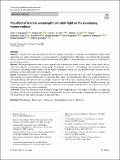Files in this item
The effect of discrete wavelengths of visible light on the developing murine embryo
Item metadata
| dc.contributor.author | Campugan, Carl A | |
| dc.contributor.author | Lim, Megan | |
| dc.contributor.author | Chow, Darren J X | |
| dc.contributor.author | Tan, Tiffany C Y | |
| dc.contributor.author | Li, Tong | |
| dc.contributor.author | Saini, Avishkar A | |
| dc.contributor.author | Orth, Antony | |
| dc.contributor.author | Reineck, Philipp | |
| dc.contributor.author | Schartner, Erik P | |
| dc.contributor.author | Thompson, Jeremy G | |
| dc.contributor.author | Dholakia, Kishan | |
| dc.contributor.author | Dunning, Kylie R | |
| dc.date.accessioned | 2022-06-30T12:30:14Z | |
| dc.date.available | 2022-06-30T12:30:14Z | |
| dc.date.issued | 2022-06-23 | |
| dc.identifier | 280299967 | |
| dc.identifier | 772c59c3-2b35-4e78-ac87-f6510ef3f238 | |
| dc.identifier | 35737174 | |
| dc.identifier | 85132564391 | |
| dc.identifier | 000814967700001 | |
| dc.identifier.citation | Campugan , C A , Lim , M , Chow , D J X , Tan , T C Y , Li , T , Saini , A A , Orth , A , Reineck , P , Schartner , E P , Thompson , J G , Dholakia , K & Dunning , K R 2022 , ' The effect of discrete wavelengths of visible light on the developing murine embryo ' , Journal of Assisted Reproduction and Genetics , vol. First Online . https://doi.org/10.1007/s10815-022-02555-4 | en |
| dc.identifier.issn | 1058-0468 | |
| dc.identifier.uri | https://hdl.handle.net/10023/25589 | |
| dc.description | Open Access funding enabled and organized by CAUL and its Member Institutions KRD is supported by a Mid-Career Fellowship from the Hospital Research Foundation (C-MCF-58–2019). KD is supported by funding from the UK Engineering and Physical Sciences Research Council (EP/P030017/1) and the Australian Research Council (FL210100099). CC acknowledges the support of a PhD scholarship jointly from the University of Adelaide and University of Nottingham. This study was funded by the Australian Research Council Centre of Excellence for Nanoscale BioPhotonics (CE140100003). PR acknowledges funding through the RMIT Vice-Chancellor’s Research Fellowship and ARC DECRA Fellowship scheme (DE200100279). | en |
| dc.description.abstract | Purpose A current focus of the IVF field is non-invasive imaging of the embryo to quantify developmental potential. Such approaches use varying wavelengths to gain maximum biological information. The impact of irradiating the developing embryo with discrete wavelengths of light is not fully understood. Here, we assess the impact of a range of wavelengths on the developing embryo. Methods Murine preimplantation embryos were exposed daily to wavelengths within the blue, green, yellow, and red spectral bands and compared to an unexposed control group. Development to blastocyst, DNA damage, and cell number/allocation to blastocyst cell lineages were assessed. For the longer wavelengths (yellow and red), pregnancy/fetal outcomes and the abundance of intracellular lipid were investigated. Results Significantly fewer embryos developed to the blastocyst stage when exposed to the yellow wavelength. Elevated DNA damage was observed within embryos exposed to blue, green, or red wavelengths. There was no effect on blastocyst cell number/lineage allocation for all wavelengths except red, where there was a significant decrease in total cell number. Pregnancy rate was significantly reduced when embryos were irradiated with the red wavelength. Weight at weaning was significantly higher when embryos were exposed to yellow or red wavelengths. Lipid abundance was significantly elevated following exposure to the yellow wavelength. Conclusion Our results demonstrate that the impact of light is wavelength-specific, with longer wavelengths also impacting the embryo. We also show that effects are energy-dependent. This data shows that damage is multifaceted and developmental rate alone may not fully reflect the impact of light exposure. | |
| dc.format.extent | 13 | |
| dc.format.extent | 1936699 | |
| dc.language.iso | eng | |
| dc.relation.ispartof | Journal of Assisted Reproduction and Genetics | en |
| dc.subject | Photodamage | en |
| dc.subject | Phototoxicity | en |
| dc.subject | Microscopy | en |
| dc.subject | Preimplantation embryo | en |
| dc.subject | Blastocyst | en |
| dc.subject | QH301 Biology | en |
| dc.subject | RG Gynecology and obstetrics | en |
| dc.subject | NDAS | en |
| dc.subject.lcc | QH301 | en |
| dc.subject.lcc | RG | en |
| dc.title | The effect of discrete wavelengths of visible light on the developing murine embryo | en |
| dc.type | Journal article | en |
| dc.contributor.sponsor | EPSRC | en |
| dc.contributor.institution | University of St Andrews. School of Physics and Astronomy | en |
| dc.contributor.institution | University of St Andrews. Sir James Mackenzie Institute for Early Diagnosis | en |
| dc.contributor.institution | University of St Andrews. Centre for Biophotonics | en |
| dc.contributor.institution | University of St Andrews. Institute of Behavioural and Neural Sciences | en |
| dc.contributor.institution | University of St Andrews. Biomedical Sciences Research Complex | en |
| dc.identifier.doi | 10.1007/s10815-022-02555-4 | |
| dc.description.status | Peer reviewed | en |
| dc.identifier.grantnumber | EP/P030017/1 | en |
This item appears in the following Collection(s)
Items in the St Andrews Research Repository are protected by copyright, with all rights reserved, unless otherwise indicated.

